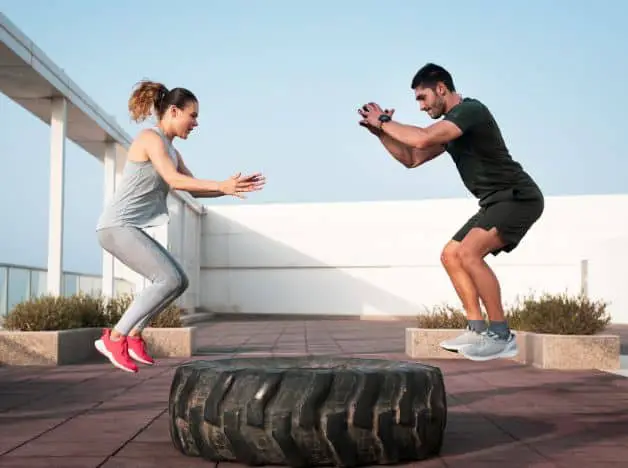Although there are workouts that may seem very similar when being done, there are major differences when it comes to the overall goals of the exercise. In this article we are going to look and see if calisthenics and plyometrics training are the same.
Both are great forms of exercises, however the purpose of each is different. Calisthenics is a form of muscle building that only uses ones own bodyweight. Although Plyometrics is typically done without any equipment also. The purpose of the exercises are to build explosive muscles and generating speed power.
If you’re planning to utilize any of these types of workouts. Having a clear vision of what your goals are would help guide you to find which exercise is better for you. For starters, if you’re looking to build muscle and have an overall workout routine, calisthenics training is a great way to do that.
On the other hand, if you’re looking more for a performance based training, such as a sports athlete or professional fighter. Using plyometrics training on top of your regular training is a great way to build explosive speed and strength.
The two can be often confused with one another. But they really do serve different purposes. Simply put calisthenics is designed through bodyweight exercises to build strength. Where as plyometrics focuses on mobility work to achieve greater quickness and explosive speed.
We will also take a bit of a deeper dive with two to further define each.

What is Calisthenics?
A choice of exercise for many that are looking to not only get stronger but to develop functional strength and making common tasks easier. Because calisthenics makes use of only your body weight when completing exercises there many other benefits that come with it.
Made up of hundreds of different exercises and progressions. Calisthenics is a form of strength building and exercise that requires using your own bodyweight as the main form of resistance.
Calisthenics is a type of work out you can do everyday, providing that you properly change your exercises to focus on certain muscle groups. Like any other exercise, resting muscles for a day or two is necessary in order for them to repair and to also prevent injury.
Progressing in calisthenic exercises is a way of showing you’re getting stronger. Often times you won’t require any equipment, however investing in parallettes or dip bars can open doors to a whole new set of challenging workouts.
What is Plyometrics?
Another form of exercise that needs very little equipment if any, is plyometrics or simply plyo. According to WebMD, plyometrics training uses speed and force to build to build muscle power.
Plyometrics training is a form of exercise that is high impact and intensity. Typically a plyo exercise starts from a resting position and into maximum force exertion, with the goal of increasing power and being more explosive.
Examples of these exercises are jumping, running, throwing and kicking. Although plyometrics training can be done by anyone from all fitness levels. A basic foundation or a certain level of fitness is recommended if you’re looking to start.
Many sport athletes in hockey, baseball, basketball and others. Take advantage of this type of exercise, to help add another layer to their game. Plyometrics training helps build muscle response to allow for quicker and more powerful movements.
Examples Of Calisthenics Training Exercises
There are many fitness individuals who swear by calisthenic workouts. If you’re just starting out and are looking to build a workout routine. Sticking to the basics like push ups, sit ups and pull ups is likely the best place to begin.
Going through the journey of calisthenics involves many different tiers. Typically in order to be able to manage a more advanced workout. There are certain levels of exercises that you should go through to build the needed muscle and endurance in order to perform certain exercises safely and successfully.
A quick example would be full planche push ups. Sure, there may be some people who can perform this difficult exercises without going through the progressions. But it’s likely not a sustainable exercise and they run a higher risk of injury. Going through the proper progressions helps develop the muscles not just in your arms but in the supporting areas of your body in order to make it a viable source of exercise.
An example progression for complete beginners would be:
- incline push ups
- regular push ups
- elevated push ups
- archer push ups
- explosive push ups
- clapping push ups
- pseudo planche push ups
- 90 degree push ups
- planche push ups pumps
- full planche push ups
As you can see, there is an extensive journey it is recommended to go through in order to reach certain levels of exercise.

What are Some Plyometrics Training Exercises
If you’re wondering if plyometrics training is for, know that a large amount of training is typically involving your legs. If you’re looking to have stronger lateral movements or height when jumping. Considering plyometric training is the likely option.
Being involved with sports at any capacity, would be another reason to being some plyometrics training. These type of workouts generally are perfect way to increase speed, mobility and flexibility. At the same these are all good reasons for overall general fitness.
Some training examples for what you’d be in for:
- Pop Squat
- Split Squat Jump
- Reverse Lunge to Knee-Up Jump
- Tuck Jump
- Jump Squat With Heel Tap
- Skater Hop
- Burpee
- Box Jump
- Single-Leg Deadlift to Jump
- Lateral Lunge to Runner’s Jump
- Hands-Release Push-Up
- Burpee Into Tuck Jump
As you can see, these type of exercises heavily involve the lower body and specifically the legs. Expect to do a lot of running, jump and lateral movements when starting plyometrics training.

Conclusion
There isn’t really a winner or loser when comparing plyometrics to calisthenics. They are both very viable forms of exercise that would help build muscle and make you sweat.
In fact, incorporating the two is likely the best option. Plyometrics alone, would likely not fit many needs for overall fitness, where calisthenics can.
Plyometrics training would bring you more mobility and agility but it would lack in the upper body strength department. Calisthenic is majority focussed on strength training, as well as joint strength and agility.
The two types of workouts bring very different elements to the table. Finding a balance between the two would allow you to reap the benefits from both.

